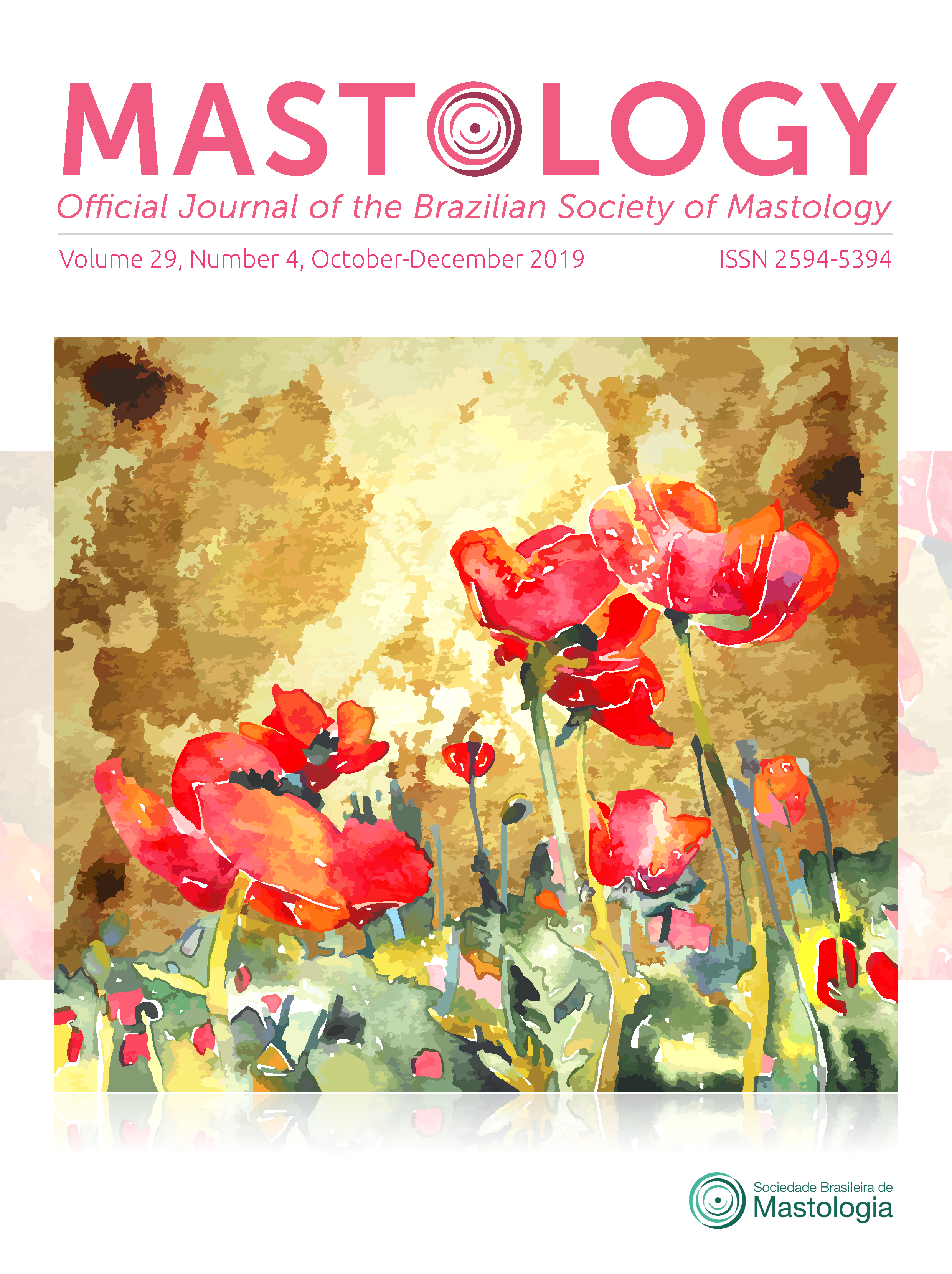Sobreviventes do câncer de mama tem menos massa magra e menor ângulo de fase após o tratamento oncológico
Palavras-chave:
câncer de mama, sobreviventes, tratamento farmacológico, composição corporalResumo
Objetivo: Avaliar o estado do peso e a composição corporal de mulheres sobreviventes do câncer de mama após tratamento oncológico. Metodologia: Trata-se de estudo clínico do tipo antes e depois, em que 27 pacientes sobreviventes do câncer de mama foram avaliadas antes (T0) e depois (T1) do tratamento oncológico (cirúrgico e clínico). Aferiram-se peso atual e estatura para definição do índice de massa corporal (IMC). A avaliação da composição corporal deu-se por impedância bioelétrica tetrapolar, sendo aferidos percentual de massa gorda e de massa magra e ângulo de fase. Aplicou-se o teste t de Student para avaliar a diferença de médias das variáveis antropométricas e de composição corporal entre T0 e T1, bem como o teste de McNemar para avaliar diferenças na prevalência de sobrepeso, adotando significância de 5%. Resultados: As pacientes têm aumento médio de 2,6 kg após o tratamento (p=0,00) e 1,15 kg/m2 no IMC (p=0,00). O percentual de massa gorda aumenta 0,6% (p=0,003) e há redução na massa magra (p=0,03) no T1. Em relação ao ângulo de fase, há diminuição média de 0,6 (p=0,026) após o tratamento. Conclusão: Mulheres sobreviventes do câncer de mama têm aumento de adiposidade, redução da massa magra e piora da integridade celular após o tratamento oncológico, o que sugere acréscimo de fatores de risco para recidiva da doença.
Downloads
Referências
Brasil. Ministerio da Saude. Instituto Nacional de Cancer. Estimativa 2018: incidencia de cancer no Brasil [Internet]. Rio de Janeiro: Inca; 2017 [accessed on February 7, 2019]. Available on: http://www1.inca.gov.br/estimativa/2018/estimativa-2018.pdf
Stewart BW, Wild CP. World Cancer Report [Internet]. Lyon: IARC; 2014 [accessed on February 13, 2019]. Available on: https://publications.iarc.fr/Non-Series-Publications/World-Cancer-Reports/World-Cancer-Report-2014
World Health Organization, International Agency for Research on Cancer. GLOBOCAN 2018: Global Cancer Observatory [Internet]. Lyon: IARC [accessed on October 1, 2018]. Available on: http://gco.iarc.fr/tomorrow/graphic-isotype
Greer JA, Amoyal N, Nisotel L, Fishbein JN, MacDonald J, Stagl J, et al. A Systematic Review of Adherence to Oral Antineoplastic Therapies. Oncologist. 2016;21(3):354-76. https://doi.org/10.1634/theoncologist.2015-0405
Trestini I, Carbognin L, Monteverdi S, Zanelli S, De Toma A, Bonaiuto C, et al. Clinical implication of changes in body composition and weight in patients with early-stage and metastatic breast cancer. Crit Rev Oncol Hematol. 2018;129:54- 66. https://doi.org/10.1016/j.critrevonc.2018.06.011
Shachar SS, Deal AM, Weinberg M, Nyrop KA, Williams GR, Nishijima TF, et al. Skeletal Muscle Measures as Predictors of Toxicity, Hospitalization, and Survival in Patients with Metastatic Breast Cancer Receiving Taxane-Based Chemotherapy. Clin Cancer Res. 2017;23(3):658-65. https://doi.org/10.1158/1078-0432.CCR-16-0940
Simone V, D’avenia M, Argentiero A, Felici C, Rizzo FM, Pergola G, et al. Obesity and Breast Cancer: Molecular Interconnections and Potential Clinical Applications. Oncologist. 2016;21(4):404- 17. https://doi.org/10.1634/theoncologist.2015-0351
Caan BJ, Cespedes Feliciano EM, Kroenke CH. The Importance of Body Composition in Explaining the Overweight Paradox in Cancer-Counterpoint. Cancer Res. 2018;78(8):1906-12. https://doi.org/10.1158/0008-5472.CAN-17-3287
da Silva EY, Carioca AA, Verde SM, Aubin E da C, Damasceno NR. Effect of chemotherapy on dietary glycemic index and load in patients with breast cancer and their relationships to body fat and phase angle. Nutr Cancer. 2015;67(4):587-93. https://doi.org/10.1080/01635581.2015.1019638
World Health Organization. Obesity: preventing and managing the global epidemic. Genebra: WHO; 2000. WHO Technical Report Series 894.
Lohman TG. Advances in body composition assessment. Current issues in exercise science series (monograph 3). Champaign: Human Kinetics, 1992. https://doi.org/10.1002/ajhb.1310050514
Barbosa-Silva MC, Barros AJ, Wang J, Heymsfield SB, Pierson RN Jr. Bioelectrical impedance analysis: population reference values for phase angle by age and sex. J Clin Nutr. 2005;82(1):49- 52. https://doi.org/10.1093/ajcn.82.1.49
Ruiz MP, Tarifa CM, Valle-Goffin JJ, Friedman ER, Slingerland JM. Obesity and adverse breast cancer risk and outcome: Mechanistic insights and strategies for intervention. CA Cancer J Clin. 2017;67(5):378-97. https://doi.org/10.3322/caac.21405
Ando S, Gelsomino L, Panza S, Giordano C, Bonofigilio D, Barone I, et al. Obesity, Leptin and Breast Cancer: Epidemiological Evidence and Proposed Mechanisms. Cancers. 2019;11(1):62. https://doi.org/10.3390/cancers11010062
Berg MM, Winkels RM, Kruif J, Laarhoven HW, Visser M, Vries JH, et al. Weight change during chemotherapy in breast cancer patients: a meta-analysis. BMC Cancer. 2017;17(1):259. https://doi.org/10.1186/s12885-017-3242-4
Heasman KZ, Sutherland HJ, Campbell JA, Elhakim T, Boyd N. Weight gain during adjuvant chemotherapy for breast cancer. Breast Cancer Res Treat. 1985;5(2):195-200. https://doi.org/10.1007/bf01805994
Araujo MC, Bezerra IN, Barbosa FS, Junger WL, Yokoo EM, Pereira RA, et al. Consumo de macronutrientes e ingestao inadequada de micronutrientes em adultos. Rev Saude Publica. 2013;47(Supl. 1):177S-89S. http://dx.doi.org/10.1590/S0034-89102013000700004
Brasil. Ministerio da Saude. Vigitel Brasil. Vigilancia de fatores risco e protecao para doencas cronicas por inquerito telefonico: estimativas sobre frequencia e distribuicao sociodemografica de fatores de risco e protecao para doencas cronicas nas capitais dos 26 estados brasileiros e no Distrito Federal em 2017 [Internet]. Brasilia: Ministerio da Saude; 2018 [accessed on December 19, 2018]. Available on: http://bvsms.saude.gov.br/bvs/publicacoes/vigitel_brasil_2017_vigilancia_fatores_riscos.pdf
World Health Organization. Recommendations and public health and policy implications. Genebra: WHO; 2018.
Atalay C, Kucuk A. The impact of weight gain during adjuvant chemotherapy on survival in breast cancer. Ulus Cerrahi Derg. 2015;31(3):124-7. https://dx.doi.org/10.5152%2FUCD.2015.3123
Yeo W, Mo F, Pang E, Suen JJ, Koh J, Loong HH, et al. Profiles of lipids, blood pressure and weight changes among premenopausal Chinese breast cancer patients after adjuvant chemotherapy. BMC Womens Health. 2017;17(1):55. https://doi.org/10.1186/s12905-017-0409-8
World Health Organization. Body fatness and weight gain and the risk of cancer. Genebra: WHO; 2018.
Parada H, Sun X, Tse CK, Olshan AF, Troester MA. Lifestyle Patterns and Survival Following Breast Cancer in the Carolina Breast Cancer Study. J Epidemiology. 2019;30(1):83-92. https://doi.org/10.1097/EDE.0000000000000933
Lauby-Secretan B, Scoccianti C, Loomis D, Grosse Y, Bianchini F, Straif K. Body Fatness and Cancer -Viewpoint of the IARC Working Group. N Engl J Med. 2016;375:794-8. https://doi.org/10.1056/NEJMsr1606602
Thomson ZO, Reeves MM. Can weight gain be prevented in women receiving treatment for breast cancer? A systematic review of intervention studies. Obes Rev. 2017;18(11):1364-73. https://doi.org/10.1111/obr.12591
Cisneros KM, Romero JE, Torres AG, Valencia ME, Estrada RO, Ortiz OT, et al. Impacto del tratamiento antineoplasico en el estado nutricional en pacientes con cancer de mama. Nutr Hosp. 2014;30(4):876-82. http://dx.doi.org/10.3305/nh.2014.30.4.7646
Mazzuca F, Onesti CE, Roberto M, Girolamo M, Botticelli A, Begini P, et al. Lean body mass wasting and toxicity in early breast cancer patients receiving anthracyclines. Oncotarget. 2018;9(39):25714-22. https://dx.doi.org/10.18632%2Foncotarget.25394
Tyagi R, Mishra S, Kumar M, Gaur N, Misra R, Prasad A. Bioelectric impedance phase angle in breast carcinoma. J Health Allied Sciences. 2014;3(1):52-5. http://dx.doi.org/10.4103/2278-344X.130617
Gupta D, Lammersfeld CA, Vashi PG, King J, Dahlk SL, Grutsch JF, et al. Bioelectrical impedance phase angle as a prognostic indicator in breast cancer. J BMC Cancer. 2008;8:249. https://doi.org/10.1186/1471-2407-8-249
Downloads
Publicado
Como Citar
Edição
Seção
Licença
Copyright (c) 2019 Sara Maria Moreira Lima Verde, Rute Mattos Dourado Esteves Justa, Vitória Maria Queiroz Machado, Carone Alves Lima, Ádila da Silva Castro, Camilla Oliveira Duarte Araújo

Este trabalho está licenciado sob uma licença Creative Commons Attribution 4.0 International License.







